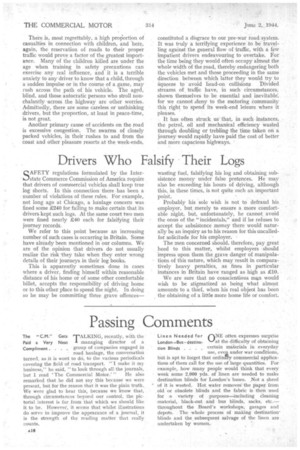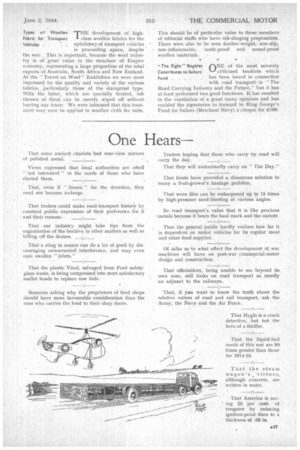Passing Comments
Page 18

Page 19

If you've noticed an error in this article please click here to report it so we can fix it.
The Gets -TALKING, recently, with the Paid a Very Neat I managing director of a
Compliment . group of companies engaged in road haulage, the conversation turned, as it is wont to do, to the various periodicals covering the field of road transport. "I make it my business," he said, "to look through all the journals, but I read 'The Commercial Motor.'" He allo remarked that he did not say this because we were present, but for the reason that it was the plain truth. We were glad to hear this, because we know that, through circumstances beyond our control, the pictorial interest is far from that which we should like it to be. However, it seems that whilst illustrations do serve to improve the appearance of a journal, it is the strength of the reading matter that really counts.
ONE often expresses surprise at the difficulty of obtaining certain materials in everyday use, eve, under war conditions, but is apt to forget that ordinaly commercial applications of them call for the use of large quantities. For example, how many people would think that every • week some 2,000 yds. of linen are needed to make destination blinds for London's buses_ Not a shred of it is wasted. Hot water removesthe 'paper from old or obsolete blinds and the fabric is then used for a variety of purposes—including cleaning material, black-out and bus blinds, sacks, etc.— throughout the Board's workshops, garages and depots. The whole process of making destination blinds and the subsequent salvage of the linen are undertaken by women. Linen Needed for Lon don Bus desti nation Blinds . . . . types of Woollen THE development of high Fabric for Transport 1 class woollen fabrics for the
Vehicles upholstery of transport vehicles is proceeding apace, despite the war.. This is important, because the wool industry is of• great value in the structure of Empire eel:Moray, representing a large proportion of the total exports of Australia, South Africa and New Zealand. At the " Travel on Wool" Exhibition we were most impressed by the quality and variety of the various fabrics, particularly those of the stainproof type. With the latter, which are specially treated, ink thrown at thern can be merely wiped off without leaving any trace: We were informed that this treatment may soon be applied to woollen cloth for suits. This should be of particular value to those members of editorial staffs who have ink-slinging propensities. There were also to be seen feather-weight, non-slip, non-inflammable, moth-proof' and sound-proof woollen materials.
"The Eight" •Bolaklet QNE of the most severely
criticized booklets which has been issued in connection with road transport. is " The Road Carrying Industry and the Future," but it has at•least performed two good functions. It has resulted in the ventilation of a great many opinions and has enabled the signatories to forward to King George's Fund for Sailors (Merchant Navy) a cheque for £100.




















































